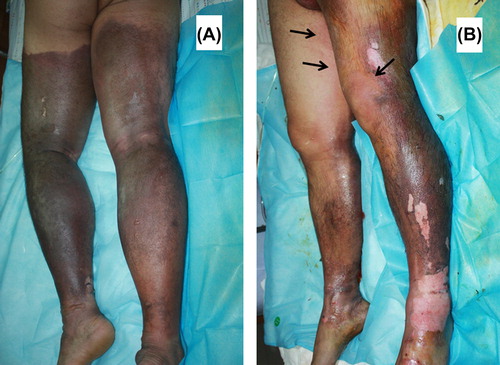To the Editor
A mixed acid solution spilled on the pants of a 40-year-old man weighing 85 kg from a broken transmission pipe in the workplace. After removing the contaminated clothes and copious lavage for 20 mins on-site, the patient was immediately sent to the emergency department 1 h post-exposure. On admission, the patient, complained of severe pain over the injury sites, and stated that the hazardous solution was concentrated sulphuric acid. Physical examination revealed burn sites distributed mainly on the lower extremities with definite boundaries (). His previous health status was good without prior diseases. By 1.5 h post-burn, patchy erythema appeared on the surrounding normal skin (). Laboratory results showed hypocalcaemia (1.34 mmol/L; normal range: 2.25–2.75 mmol/L), elevated white blood cells (11.4 × 109/L; normal range: 4–10 × 109/L), slight acidosis (pH: 7.30), and normal serum potassium and magnesium levels. The urinary fluoride level was 35 (normal: ∼1.7) mg/L. Chest X-ray and electrocardiography indicated no abnormalities. The technical staff in the factory confirmed that the solution was 80% sulphuric and 4% hydrofluoric acid (HF). Accordingly, 10% calcium gluconate and 5% sodium bicarbonate solution were administered intravenously under electrocardiographic monitoring. The burned sites were first washed with 5% sodium bicarbonate solution, followed by subcutaneous injection of 5% calcium gluconate solution. Emergency tangential escharectomy was performed, and the excised wounds were treated by a wet compress of 10% calcium gluconate solution and covered with xenografts. After surgery, the patient's vital signs were stable without evident electrolyte imbalance. The patient received autografts on the 7th day, and was discharged by the 20th day post-burn.

Concentrated sulphuric acid causes coagulative tissue necrosis, which is conservatively treated. HF burns can be life-threatening, since the released fluoride ions can cause electrolyte imbalance and severe arrhythmia by binding to calcium and magnesium ions.Citation1 Death has been reported from HF burns of 2.5% total body surface area or TBSA.Citation2 Treatment should be immediately undertaken for patients with HF injuries,Citation3 such as removal of clothing and copious irrigation.Citation4 For patients with mixed-acid burns, like the patient described here, the diagnosis could be difficult. The chemical constituents should be identified quickly so as not to delay appropriate treatment. Nonspecific signs and symptoms of HF burns, such as severe pain and patchy erythema, should be concerning. The laboratory tests in this case revealed hypocalcaemia and high urinary fluoride, suggesting the fluoride poisoning. Since HF penetrates the entire skin in several minutes,Citation5 antidotes such as calcium gluconate solution should be used immediately to block the ongoing absorption of HF.Citation1 Due to the potential risk of sulphuric acid burns accelerating HF absorption, emergency escharectomy was performed for more thorough debridement in this case. Taking safety measures at the workplace to avoid similar events is necessary.
Declaration of interest
The authors report no conflicts of interest. The authors alone are responsible for the content and writing of the paper.
References
- Wang X, Zhang Y, Ni L, You C, Ye C, Jiang R, et al. A review of treatment strategies for hydrofluoric acid burns: current status and future prospects. Burns 2014; 40:1447–1457.
- Bertolini JC. Hydrofluoric acid: a review of toxicity. J Emerg Med 1992; 10:163–168.
- Kirkpatrick JJ, Enion DS, Burd DA. Hydrofluoric acid burns: a review. Burns 1995; 21:483–493.
- Brent J. Water-based solutions are the best decontaminating fluids for dermal corrosive exposures: a mini review. Clinical toxicology 2013; 51:731–736.
- Burgher F, Mathieu L, Lati E, Gasser P, Peno-Mazzarino L, Blomet J, et al. Experimental 70% hydrofluoric acid burns: histological observations in an established human skin explants ex vivo model. Cutan Ocul Toxicol 2011; 30:100–107.
